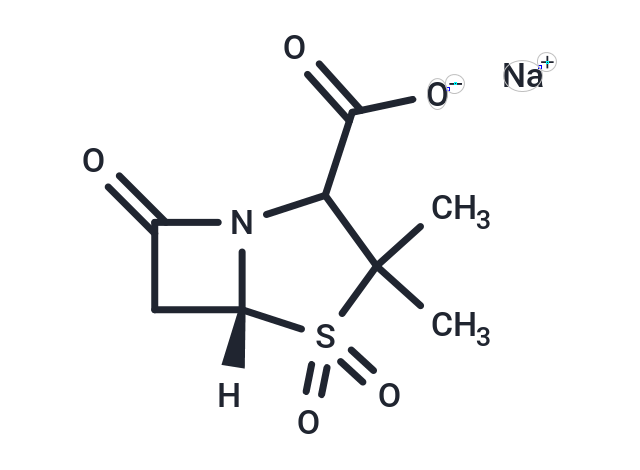Shopping Cart
- Remove All
 Your shopping cart is currently empty
Your shopping cart is currently empty

Sulbactam (CP45899) is a semi-synthetic beta-lactamase inhibitor. The beta-lactam ring of sulbactam irreversibly binds to beta-lactamase at or near its active site, thereby blocking enzyme activity and preventing metabolism of other beta-lactam antibiotics by the enzyme. Combining this agent with a beta-lactamase susceptible antibiotic, such as penicillins or a cephalosporin, to treat infections caused by beta-lactamase producing organisms, results in a decreased turnover rate of the beta-lactamase sensitive antibiotic and enhances its antibacterial activity.

| Pack Size | Price | Availability | Quantity |
|---|---|---|---|
| 50 mg | 36 € | In Stock | |
| 100 mg | 47 € | In Stock | |
| 200 mg | 55 € | In Stock | |
| 500 mg | 87 € | In Stock | |
| 1 mL x 10 mM (in DMSO) | 44 € | In Stock |
| Description | Sulbactam (CP45899) is a semi-synthetic beta-lactamase inhibitor. The beta-lactam ring of sulbactam irreversibly binds to beta-lactamase at or near its active site, thereby blocking enzyme activity and preventing metabolism of other beta-lactam antibiotics by the enzyme. Combining this agent with a beta-lactamase susceptible antibiotic, such as penicillins or a cephalosporin, to treat infections caused by beta-lactamase producing organisms, results in a decreased turnover rate of the beta-lactamase sensitive antibiotic and enhances its antibacterial activity. |
| Alias | CP45899 |
| Molecular Weight | 233.24 |
| Formula | C8H11NO5S |
| Cas No. | 68373-14-8 |
| Smiles | [Na+].[H][C@@]12CC(=O)N1C(C([O-])=O)C(C)(C)S2(=O)=O |
| Relative Density. | 1.62 g/cm3 (Predicted) |
| Storage | Powder: -20°C for 3 years | In solvent: -80°C for 1 year | Shipping with blue ice. | |||||||||||||||||||||||||||||||||||
| Solubility Information | H2O: 43 mg/mL (184.4 mM) DMSO: 70 mg/mL (300.12 mM), Sonication is recommended. Ethanol: 44 mg/mL (188.6 mM) | |||||||||||||||||||||||||||||||||||
Solution Preparation Table | ||||||||||||||||||||||||||||||||||||
H2O/Ethanol/DMSO
| ||||||||||||||||||||||||||||||||||||

Copyright © 2015-2024 TargetMol Chemicals Inc. All Rights Reserved.